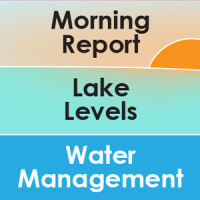SAVANNAH, Ga. – The three reservoirs on the Savannah River operated by the U.S. Army Corps of Engineers entered the first drought level today when pool elevation at Thurmond Lake dipped below 326 feet above mean sea level (ft-msl). Entering Trigger Level 1 activates the Corps’ drought management plan which limits the discharge rate from the Thurmond Dam.
Under the existing drought plan, the Corps limits outflow from Thurmond Dam to 4,200 cubic feet per second (cfs), averaged over the week. Reducing outflow conserves more water in the reservoirs but decreases the amount of hydropower generated through the dams.
The pool elevation on July 25 was 325.79 ft-msl at Thurmond Lake. Once either Hartwell Lake or Thurmond Lake enters drought conditions, water managers reduce releases from Thurmond Dam until Hartwell and Thurmond rise 2 feet above the trigger. Level 1 is defined as below 656 ft-msl for Hartwell and 326 ft-msl for Thurmond.
In addition, the 28-day average flow of the Broad River into Thurmond Lake is 11 percent of normal. The flow in that unregulated river and pool elevations in the reservoirs determine discharges from Thurmond Dam.
Water managers will reduce outflows to 4,200 cfs averaged over 24 hours today. They expect the Broad River to drop below 10 percent of normal flow later this week causing an additional 200 cfs to 4,000 cfs.
Corps officials urge the public to use caution when boating, swimming or fishing. As the reservoir levels decline, underwater obstructions will be closer to the surface. This is particularly dangerous for boaters and skiers. Swimmers should not venture outside designated swimming areas. All visitors should wear a life jacket when swimming, boating or fishing. Dock owners may need to move their docks to remain in adequately deep water.
“Below average rainfall in 2016 gradually reduced inflows into the reservoirs,” said Stan Simpson, a hydrologist and a senior water manager for the Savannah District. “However, because of very heavy rains early last winter, the reservoirs and inflowing tributaries kept the reservoirs full. By following our long-established water manual, we managed to keep reservoirs above drought triggers in spite of the rain deficit.”
Water managers and dam operators reduced outflows from the Thurmond Dam earlier in the month and relied on increased pumpback operations at Russell Dam to retain water in the three-reservoir system.
Pump-back allows the Corps to generate electricity at the Russell Dam during peak afternoon demand times then reverse turbine direction at night to return the water for reuse the next day, providing power even during drought.
Electricity to drive the reverse turbines for pump-back must be purchased on the open market. Even with pump-back operations the Savannah District fell approximately 4,000 megawatt hours short of its contract obligations for providing power.
The congressionally authorized purposes of the reservoirs include water supply, water quality, recreation, flood risk management, navigation, hydropower production, and fish and wildlife management.
More than 10 public water systems and industrial users draw water directly from the reservoirs and even more draw from the Savannah River downstream of Thurmond Dam. Downstream users include the Augusta and Savannah in Georgia and North Augusta, Aiken and Jasper County in South Carolina. Threatened and endangered species and the Savannah National Wildlife Refuge also depend on the river.
For more information on current lake levels and projections, contact the Savannah District Corporate Communications Office at 912-652-5014, or visit the District’s lake-level website.
~ Billy Birdwell, Corporate Communications Office

